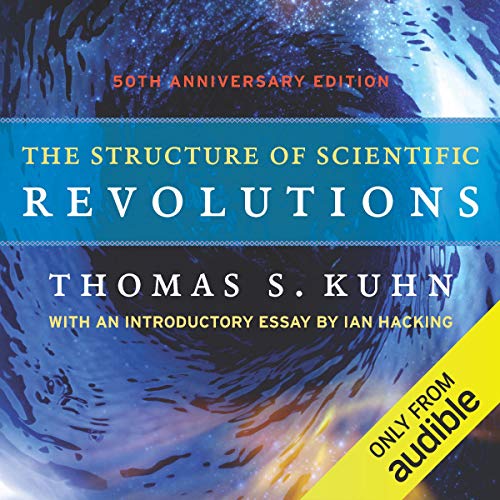Thomas S. Kuhn’s “The Structure of Scientific Revolutions” explores paradigm shifts in scientific thought. It highlights how scientific progress often comes through revolutionary changes.
Thomas S. Kuhn’s seminal work, “The Structure of Scientific Revolutions,” profoundly impacts our understanding of scientific progress. Published in 1962, this book introduces the concept of paradigm shifts, describing how science advances through revolutionary changes rather than gradual evolution. Kuhn argues that normal science operates within prevailing frameworks, but anomalies eventually lead to new paradigms.
This idea has influenced various fields beyond science, including philosophy and sociology. The audiobook version offers an accessible way to engage with Kuhn’s groundbreaking theories. It provides valuable insights into the dynamic nature of scientific inquiry, making it essential for anyone interested in the history and philosophy of science.

Credit: www.amazon.com
Introduction To Thomas S. Kuhn
Thomas S. Kuhn is known for his groundbreaking work, “The Structure of Scientific Revolutions.” This book changed how people view science. It introduced the idea of paradigm shifts in scientific progress.
The audiobook version of this classic is now available. Listening to it brings Kuhn’s ideas to life. Let’s explore more about Thomas S. Kuhn, the man behind this influential book.
Early Life And Education
Thomas Samuel Kuhn was born on July 18, 1922, in Cincinnati, Ohio. His early life was marked by a strong interest in science and learning. Kuhn’s father was an industrial engineer, and his mother was a writer and editor.
In 1943, Kuhn graduated summa cum laude from Harvard University with a Bachelor’s degree in Physics. He continued his education at Harvard, earning a Master’s degree in 1946 and a Ph.D. in 1949. His academic excellence laid a strong foundation for his future work.
Journey Into Philosophy Of Science
After completing his education, Kuhn began teaching at Harvard. During this time, he developed an interest in the history of science. This interest led him to study how scientific theories change over time. He discovered that science does not progress linearly but through revolutionary changes.
In 1962, Kuhn published “The Structure of Scientific Revolutions.” This book introduced the concept of paradigm shifts. A paradigm shift occurs when a new scientific theory replaces an old one. Kuhn’s ideas challenged the traditional view of scientific progress.
The audiobook version allows listeners to grasp these complex ideas easily. It brings Kuhn’s work to a broader audience. Understanding Kuhn’s journey helps appreciate his contributions to the philosophy of science.
| Year | Milestone |
|---|---|
| 1922 | Born in Cincinnati, Ohio |
| 1943 | Graduated from Harvard University |
| 1949 | Earned Ph.D. from Harvard University |
| 1962 | Published “The Structure of Scientific Revolutions” |
Listening to the audiobook of “The Structure of Scientific Revolutions” offers a deep dive into Kuhn’s groundbreaking ideas. His work remains influential in understanding scientific progress.

Credit: press.uchicago.edu
Core Concepts In ‘the Structure Of Scientific Revolutions’
Thomas S. Kuhn’s ‘The Structure of Scientific Revolutions’ is a landmark work. It changed how we think about science. This audiobook brings Kuhn’s ideas to life. Let’s explore the core concepts.
Paradigm Shifts Explained
Kuhn introduced the idea of paradigm shifts. A paradigm is a set of beliefs. It guides scientists in their work. When a paradigm shifts, it changes the field completely.
- A paradigm shift is a major change in scientific thinking.
- Old ideas are replaced with new ones.
- This shift often leads to groundbreaking discoveries.
Paradigm shifts are rare but powerful. They reshape our understanding of the world.
Scientific Anomalies And Crises
Science doesn’t always go smoothly. Sometimes, scientists find anomalies. These are facts that don’t fit the current paradigm.
- Anomalies are unexpected results in experiments.
- They challenge the existing scientific framework.
- If many anomalies appear, a crisis happens.
A scientific crisis forces a reevaluation of beliefs. It often leads to a paradigm shift.
Normal Science Vs. Revolutionary Science
Kuhn also discussed normal science and revolutionary science. Normal science is the daily work of scientists. They solve puzzles within the current paradigm.
| Normal Science | Revolutionary Science |
|---|---|
| Works within existing paradigms | Challenges and changes paradigms |
| Focused on solving small puzzles | Leads to major breakthroughs |
| Incremental progress | Radical changes |
Revolutionary science is different. It breaks away from the norm. It brings new theories and ideas.
Impact And Reception Of Kuhn’s Work
Thomas S. Kuhn’s “The Structure of Scientific Revolutions” changed how we view science. The audiobook version brings his ideas to life. Many have praised and debated his work. Let’s explore its influence and reception.
Influencing Scientific Thought
Kuhn’s book introduced the term “paradigm shift.” This concept transformed scientific thinking. Scientists began to see science as evolving through major changes. These shifts replace old theories with new ones.
Before Kuhn, science was seen as a steady progress. His work showed that science has disruptive periods. These periods lead to new ways of understanding. This idea has influenced many fields, not just science.
Critiques And Controversies
Kuhn’s work has sparked many debates. Some scientists agree with his views. Others have challenged his ideas. They argue that science can be both gradual and revolutionary.
Some critics say Kuhn’s book is too focused on history. They believe he overlooks the role of technology and society. Despite these critiques, his work remains significant.
Legacy And Continuing Relevance
Kuhn’s ideas continue to be relevant today. His concept of paradigm shifts is used in various fields. Business, sociology, and education all use his framework.
Many scholars still study and expand on his theories. His work is part of academic discussions and research. The audiobook helps a new generation understand his impact.
The enduring influence of “The Structure of Scientific Revolutions” cannot be overstated. Kuhn’s work has changed how we understand scientific progress.

Credit: press.uchicago.edu
Conclusion
The audiobook of “The Structure of Scientific Revolutions” by Thomas S. Kuhn is a must-listen. It offers fresh insights into scientific progress. Engaging and thought-provoking, it challenges our understanding of science. This audiobook is perfect for anyone interested in the evolution of scientific ideas.
Don’t miss this enriching experience.



